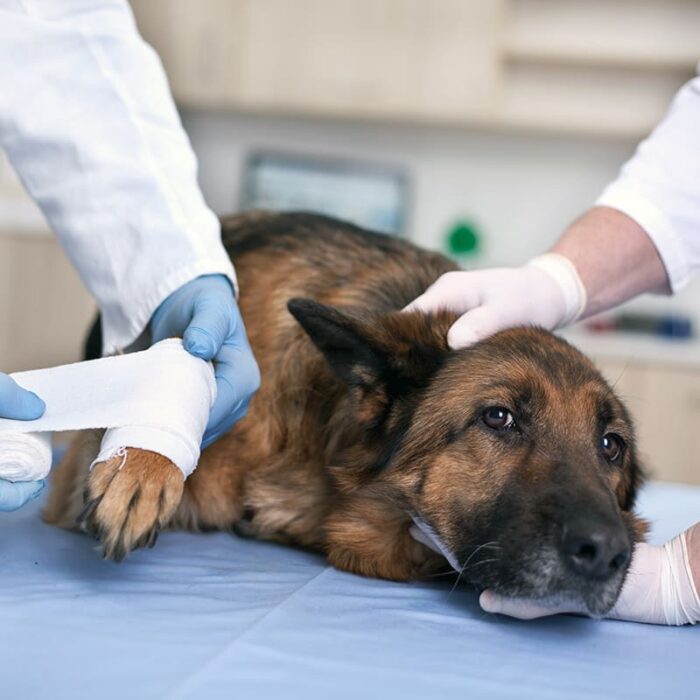You ever noticed that your dog came home from the garden after playing, and it has one of its legs hanging, or have you been seeing that one of its legs is getting stiff and can no longer walk properly? It gets you are wondering, “why is my German Shepherd limping?”
Limping in dogs is of two sorts. It can be gradual, which is usually caused by certain health conditions. It can also be sudden, as a result of injury or trauma.
Limping sometimes might just require that you let the dog rest and take better care of it. Other times, you will need the service of a veterinarian urgently.
Why is my German Shepherd limping all of a sudden?
Limping in dogs comes as a result of either a physical wound or an ailment. Limping regularly demonstrates that your dog is in some sort of distress. In any case, it might likewise imply that your dog is unable to move and whether or not it is in agony. There are several causes of dog limping, some include;
- Sprain
- Item stuck in paw or foot
- injury on the foot
- Joint inflammation
- Trauma
- Dysplasia
In the case of my dog limping, what should I do?
A few limps are more genuine than others, so the initial phase in giving emergency treatment is to survey the limp. Watch your dog walk. Distinguish the limping leg from the healthy leg. Observe the limping. Check how the dog walks, whether it hangs the limping leg or it walks with it. Discern whether the limping was sudden or gradual. Take note of how quickly the limping escalates. You can also try to discover if the limping is constant throughout the day or gets worse at a particular time. If your dog is in serious pain, you shouldn’t try to examine it. Regardless of whether she’s not in evident distress, trying to examine broken bones or disengaged joints can cause needless torment and may deteriorate the injury. To determine the severity of an injury, it is essential to note that most dogs cannot walk on a wrecked leg or a dislocated bone.
When you notice an injury that makes your dog limp and you want to examine it, get someone else with you, one of you will restrain the dog while the other person checks the injury. This is important because when dogs are in pain, they tend to bite anyone, even their owners. If the examination becomes unbearably painful for the dog, you should stop and not put the dog in more pain. What is left is for you to take the dog to a veterinarian.
After you recognize the affected leg, you can proceed to pinpoint the source of the pain. Examine his legs by looking between his toes for pieces of objects or particles that might be stuck in between them, or redness. Analyze the cushions for cuts or penetrates and evaluate each toenail for breaks or nail bed contaminations when you notice anything out of the ordinary; waste no time before calling the veterinary doctor.
Can my dogs limp heal on its own?
A dog’s limp can heal on its own. If the limping of a dog is not severe, attempt to keep it tranquil and agreeable. Oblige your dog to rest, and do not let him partake in any physical activity. Try not to permit your dog to exercise or hop. Keep the dog away from staircases if possible; if not, you can help carry the dog up and down the stairs. You may keep your dog to a little territory. Let it lay down most of the day. If the limping leg doesn’t begin to heal within a day or two, it is best to take the dog to the vet.
When should my dog visit the vet for limping?
There are two sorts of limps: gradual limps and sudden limps. Gradual beginning limps happen gradually over the long haul. Sudden limps happen rapidly, similar to their name suggests, generally after a physical issue or injury. Knowing whether your dog’s limp is gradual or sudden can help your veterinarian ascertain the potential reasons for your dog’s limp and can assist you with deciding whether your dog’s limp is a veterinary crisis.
Generally, it is better to avoid any risks and arrange a meeting with a veterinarian when you notice a limp that is continuous for minutes, however as it is with humans, dogs appear to have a talent for getting injured outside their regular playtime. So how long should you wait before you out a call through to your vet or visit the vet’s office?
Gradual limps or sudden limps that do not appear to trouble your dog in an alarming fashion can generally be observed for a couple of hours, and sometimes, may even sort themselves out all alone during this observation period. In some other cases, be that as it may, your dog might hardly be able to wait because of the pain.
Broken bones or disjoined joints require the quick attention of a veterinary doctor, and nerve harm can be an indication of a more genuine neurological condition or spinal contusion. You need to get your dog into the veterinarian or a veterinary clinic if your dog’s limb shows any of these signs
- Dislocation
- Expansion
- Aggravated temperature
- Clear break
How do I know if my German shepherd has hip dysplasia?
A few dogs start to indicate hip dysplasia when they are pretty much as youthful as four months old. Others come about it with osteoarthritis as they age. In the two cases, there are a couple of manifestations that dog owners ought to be acquainted with. These signs may differ based on the seriousness of the infection, the degree of aggravation, the level of detachment in the joint, and how long the dog has experienced hip dysplasia. Some of the following causes can recognize hip dysplasia;
- Reduced movement
- Trouble rising, hopping, running, or climbing steps
- Weakness in the rear end
- Grinding in the joint during development
- A decrease in thigh size
- Recognizable development of the shoulder muscles as they make up for the rear end etc.
Final Thoughts
There are numerous choices to help a limping dog. Your dog will have a higher possibility of healing faster if you give emergency treatment immediately you notice the limp and also seek a veterinary assessment when it is required.
Your vet may suggest more sophisticated diagnostics or a second assessment from a veterinary expert on account of a significant issue, or if your dog has a limp, that doesn’t disappear.
Make sure to follow up routinely with your veterinarian about the status of your dog’s limping. Do not hold back till situations get out of hand. If things are not improving all alone, your vet should change the treatment plan.






